Keeping eels at home is not for everyone, but I think we can all agree that it can be spectacular to own one. In this post I will share an introduction to the top pet eels along with a detailed care guide!

So, naturally, you got curious as to what types of eels can live in freshwater because you don’t really feel like switching to a marine tank soon.
But what more should you know about these creatures?
Are they aggressive to other fish? Will you be able to provide what they eat?
Is an eel suitable for a freshwater aquarium pet at all or does it have some extraordinary needs that can’t be met?
If yes, are there species that remain small, or will they all outgrow a decently-sized fish tank?
Which one is the smallest one?
I’ve put together a list to help with all of that.
True eels are ray-finned fish that belong to the Anguilliformes order which is found under the bony vertebrates classification. This includes all the popular species, such as the Moray eel, Spaghetti eel, American eel, European eel, and others.
The Anguilliformes all spawn in the ocean, where their parents have bred.
However, the spawns will migrate to a body of freshwater.
The eels spend a portion of their life there, in brackish to freshwater.
This relocation is only temporary though – they remain marine in nature and need the salinity.
Towards maturity, they will return to the ocean to reproduce. Salinity is required for a healthy true eel. Therefore, there are no true freshwater eels. Unfortunately, many fish stores will market these eels as freshwater inhabitants.
This results in ignorant people taking them home.
After a couple of months the eel dies, because it could not properly fulfill its life cycle…
There are also eel-like freshwater fish. They will behave and look like an eel, though not a real member of the family. The dragon goby, for example, is sometimes classified as a freshwater pet.
Objectively, it can gradually adapt to tolerate such conditions.
However, it will feel most comfortable in brackish water, so it does not belong to this classification.
Sidenote: Do you want to watch this article instead of reading it? Checkout the highlight video below from our YouTube Channel (Or read the more detailed article below), be sure to Subscribe For More Great Fishkeeping Content:
Anyway, let me show you 13 types of freshwater aquarium eels that will leave your guests in awe.
13 Freshwater Eels That Can be Kept as Aquarium Pets
Freshwater eels that can be kept as pets are actually look-alike fish with similar behavior to the true members of the family. True eel species will need to migrate to saltwater eventually, even though your local fish store may claim otherwise.
Mentioned below are only the ones that can spend their full lives in 100% salt-free water.
The known species of freshwater aquarium eels that can be kept as pets are:
1. Tire Track Eel (Mastacembelus favus)

| Water temperature: | 73 to 82 °F (~23 to ~28 °C) |
| pH: | 6.5 to 8 |
| Water Hardness: | 5 to 15 dH |
| Recommended tank size: | At least 35 gallons for youngsters and at least 125 gallons for adults. |
| Grows up to: | 30″ (75 cm) |
The Tire Track Eel is a typical representative of the Mastacembelus genus of spiny eel fish, the species of which are characterized by brownish and, often, spotted bodies.
These elongated fish will have a character on their own.
Though a little shy at first they will eventually feel more confident to swim around your tank.
These fish need their safe space and would like to hide in caves or bury themselves in the soft substrate.
Speaking of which the substrate should be non-abrasive, with sand being a good option.
Anyway, Tire Track Eels also enjoy having a PVC pipe lying around for them to hang out in.
When M. favus feels comfortable enough it will start to show itself more often.
Sometimes they get too comfortable and will try and steal food from other tank mates, right off their mouths.
If you do plan to look after more than one, then you have a “window” of 3 to 4 months.
After that, the Tire track eel gets used to living on its own and might not tolerate others of its kind.
They are semi-aggressive fish and will try to eat whatever fits in their mouth.
Keeping them with smaller fish is not a bright idea.
Tire tracks will need a tank with other similarly-sized or larger fish, compatible in aggression levels (think mature cichlids).
As they reach up to 2.5 feet or around 75 cm these eels need a fairly large tank of AT LEAST 125 gallons.
In the wild, they occupy a territory of several square feet.
If you plan on keeping two from the same species be sure to have an even larger tank as they can get pretty territorial.
Mind that the growth rate of tire track eels can be fast when they’re young but the pace slows down with time.
They will grow with about an inch and a half (around 4 cm) per month with proper care.
Tire track eels will do fairly well (or even better) in slightly salt-ish water.
The salt in the water will make them even harder than they already are.
It will give them a fair dose of protection from parasites too. One parasite that commonly causes issues with these eels is the freshwater type of the ich parasite.
Note that the salinity levels in the water should still be far from what’s considered “brackish”. Anyhow, Tire track eels love to snack on a black worm, nightcrawler, krill, Mysis, Cyclops, and ocean plankton, with the occasional freeze-dried bloodworm.
Flake food is a no-no.
Tire tracks need a strong water movement that will oxygenate the water well enough for them to feel homelike.
I recommend this equipment for a Tire Track Eel:
- For the lightning set up, you can check out Current USA Satellite+ PRO on Amazon or see if Chewy has a deal on it. These lights are easy to work with, dimmable (which is good for the eel), and can support stem aquarium plants.
The Tire Track Eel will appreciate some deeply-rooted stem plants as they will provide it with more shelter and won’t be uprooted easily.
- When it comes to the filtration of a 125-gallon tank with a messy creatures such as eels, I recommend using two canister filters in order to maintain clean water. The primary filtration should be done by a strong canister filter such as this one here and the complementary unit could be something less powerful like this filter here.
- A good heater for a Tire Track eel aquarium would be the Eihem Jager. Click the link to see it on Amazon or compare prices with Chewy here. For a tank of this size, I recommend getting two separate 300-Watt Eheim Jagers and placing them in the opposite sides of the aquarium.
- This species of eel prefers richly oxygenated water, so a good way to achieve that would be through an air stone: Hygger Airstone + Whisper air pump + airline tubing to connect the two.
2. Yellowtail Spiny Eel (Macrognathus pancalus)

| Water temperature: | 73 to 81 °F (~23 to ~27 °C) |
| pH: | 7 to 8.5 |
| Water Hardness: | 12 to 25 dH |
| Recommended tank size: | 30 gallons |
| Grows up to: | 4 to 7 inches (10 – 15 cm) |
The Macrognathus pancalus is a yellow freshwater eel that’s part of the spiny eel family.
Yellowtails are among the smaller freshwater eels with a maximum size of just 7 inches (18 cm).
Since they’re a nocturnal species, they’ll spend most of the day buried in the substrate.
Therefore, you need to provide them with enough cover in the form of plant thickets, PVC pipes, or rocky caves.
Needless to say, freshwater yellow eels prefer a soft substrate which mimics their natural environment.
Even though they’re mostly peaceful, these spine eels might gobble smaller fish during the night.
Due to this, they shouldn’t be kept with neon tetras or small rasboras.
Here are some suitable Yellowtail eel tank mates:
- Boseman’s Rainbowfish – Melanotaenia boesemani
- Pearl gourami – Trichopodus leerii
- Pearl Cichlid – Geophagus braziliensis
Yellowtail eels like to snack on white mosquito larvae, bloodworms, and brine shrimp.
Depending on their size, they might also be fed with mysis shrimp and chopped krill.
3. Fire Eel (Mastacembelus erythrotaenia)
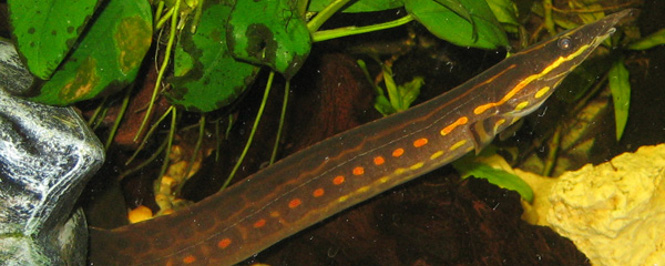
| Water temperature: | 73 to 82 °F (~23 to ~28 °C) |
| pH: | 6.5 to 8 |
| Water Hardness: | 5 to 15 dH |
| Recommended tank size: | At least 55 gallons for youngsters and 180 gallons or above for adults. |
| Grows up to: | 40″ (100 cm) |
Coming from the same Mastacembelus genus as their Tire Track Eel relatives, the Fire eels grow the largest of all the spiny eels.
They can reach up 3+ feet (around 1 meter) in the wild.
However, in aquariums, they will not grow as much, as with all other spiny eels.
Nonetheless, you should be prepared to have a full-sized monster of at least 30 inches or 76 cm.
A fire eel does very well in community tanks as it mostly ignores fish that are not perceived as food. They may look mean but fire eels are not dangerous to their tank mates or humans.
They will occasionally try to “taste” your hand if you stick it in the tank, but their teeth are too small to cause any serious damage.
Fire eels should be kept with large, yet calm fish. Here’s a list of suitable fire eel tank mates:
- Tire Track eel
- Peacock eel
- Ropefish
They become aggressive towards one another, sparring for territory.
This is a bottom-dwelling fish, so be cautious of what size your other bottom-dwellers are or aim to be.
The Fire eels’ favorite activity, if I can call it that way, is to burrow themselves in the gravel.
When looking after one of those eels, consider a gravel layer of 2.5″ (6.3 cm) or more. Visit to link to see how to calculate that.
Anyway, it is common for a fire eel to uproot plants.
Switching to floating plants is to be expected when keeping this species.
The plants will also dim the lighting in the fish tank.
Fire eels enjoy a darker aquarium and will appreciate your efforts.
Abundant hiding places should be available, as these fish like to play a lot of “hide and seek”.
Having the occasional driftwood centerpiece (a guide on where to find those for free) and rock work along with caves is a must. This fish is generally hardy and the only difficulty fishkeepers face is its size.
At first, a 35 to 55-gallon tank would fit its needs, but a mature specimen would need no less than a 180-gallon aquarium.
One cool thing about Fire eels is that they will recognize their owners so they can be hand-fed.
Fire eels like to eat krill and frozen bloodworms when they’re juveniles, and also some ghost shrimp.
When they reach maturity they will prefer eating live nightcrawlers and will be happy to stick to that.
In the wild, they usually snack on black worms, so see if you have access to those.
Classified as an omnivore they do rarely snack on vegetables but prefer live prey as a main source of food.
Mind that these fish are nocturnal and will come out mostly during the night.
If, however, you provide them with low, subdued light they can feel comfortable enough to show up during the daytime.
Here’s what aquarium equipment I recommend for a Fire Eel:
- Because you’ll likely switch to floating plants when looking after a Fire Eel, a couple of simple lighting fixtures like the NICREW Classic LED would do as a source of light for the tank.
- To filter 180 gallons of aquarium water you’ll need a rock solid filtration system. I would recommend using the Eheim 2262 canister filter.
To make up for the full water volume you should still add a secondary filter. I recommend the Fluval FX6 for a tank of this gallon capacity. That combo guarantees your Fire Eel aquarium proper filtration.
- For the heating of the eel tank, I recommend that you check Eheim Jager on Amazon or Chewy, as it will manage to keep the water temperature consistent. Use 2 to 3 of the 300-Watt versions.
4. Zig-Zag Eel (Mastacembelus armatus)
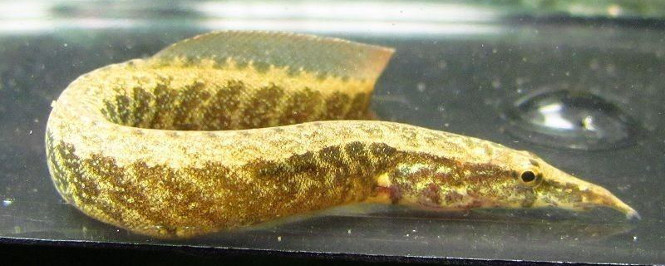
| Water temperature: | 73 to 82 °F (~23 to ~28 °C) |
| pH: | 6.5 to 8 |
| Water Hardness: | 5 to 15 dH |
| Recommended tank size: | At least 35 gallons for juveniles and a 150+ gallon tank for adults. |
| Grows up to: | 40″ (100 cm) |
The Tire Track Eel, the Fire Eel, and the Zig-Zag Eel are three of the over 60 species within the genus Mastacembelus.
The Zig-Zag Eel is often confused with the Tire track eel in pet shops, but the more reputable online stores for live freshwater fish label them right.
The confusion occurs, because when the eel fish are being sold as juveniles, there isn’t much distinctive coloration between the two species.
The only way to tell apart a zig-zag eel from its tire track cousin is the pattern and its pronunciation.
The Tire track eel’s coloration looks more like O’s and zig-zag’s one looks more like slanting I’s.
The reason I took the time to describe the differences in juveniles is that the zig-zag eel can grow way larger than the tire track eel.
Mature Zig Zag eels can reach a maximum size of up to 3 feet (90 cm).
However, this happens in the course of years as these “eels” have a lifespan of around 18 years with good care.
It should also be noted that in captivity Zig Zag Eels do tend to remain smaller, so a realistic expectation would be around 2 feet or 60 cm.
The growth rate of M. armatus is similar to that of M. favus capping at 1-1.6 inches (2.5 to 3.8 cm) per month at a young age provided there is abundant food and lots of living space.
As spiny eels go these guys will also like to burrow in the aquarium’s substrate and hide for the most part during the daytime.
Fine gravel or inert sand substrate is recommended. During the night these freshwater eels will become more active and hunt for prey.
They are full-blown predators and will try to eat anything that fits in their mouths.
That being said, compatible tank mates for a Zig-Zag Eel are all fish that are large enough not to get eaten.
Here are some examples:
- Striped Raphael Catfish (Platydoras armatulus)
- Rope Fish (Erpetoichthys calabaricus)
- Oscar Fish (Astronotus ocellatus)
The zig-zag eel is semi-aggressive so fish with the same temperament are recommended.
Aggressive fish are known to have killed spiny eels if the eel was not a respectable size.
The minimum tank size for zig-zag eels is 125 gallons.
However, when this fish reaches 1.5 to 2 feet it is strongly recommended to relocate them to a bigger tank as they will feel confined.
The zig-zag eel’s diet consists of frozen bloodworm and shrimp, live ghost shrimp, tubifex, and Cyclops. Zig-Zag eels will try to eat most small-sized aquarium fish if given the opportunity.
I recommend this equipment for a Zig-Zag Eel:
- If you are looking for good yet budget-friendly aquarium lights, that can help you grow some easy aquatic plants, check out the NICREW ClassicLED on Amazon.com.
- Same as with Fire Eels, to heat up a bigger tank, I recommend EHEIM’s Jager aquarium heater. It’s a strong heater that will provide and keep the needed temperature with just a few touches.
Use no less than three 300-Watt units in your 180-gallon Zig-Zag Eel aquarium.
- When it comes to filtration in an aquarium that holds 150+ gallons of water, my personal favorite is Eheim AEH2262380. This canister filter is extremely strong and long-lasting.
It’s also capable of moving a lot of aquarium water each hour.
5. Bichirs (Polypterus spp.)
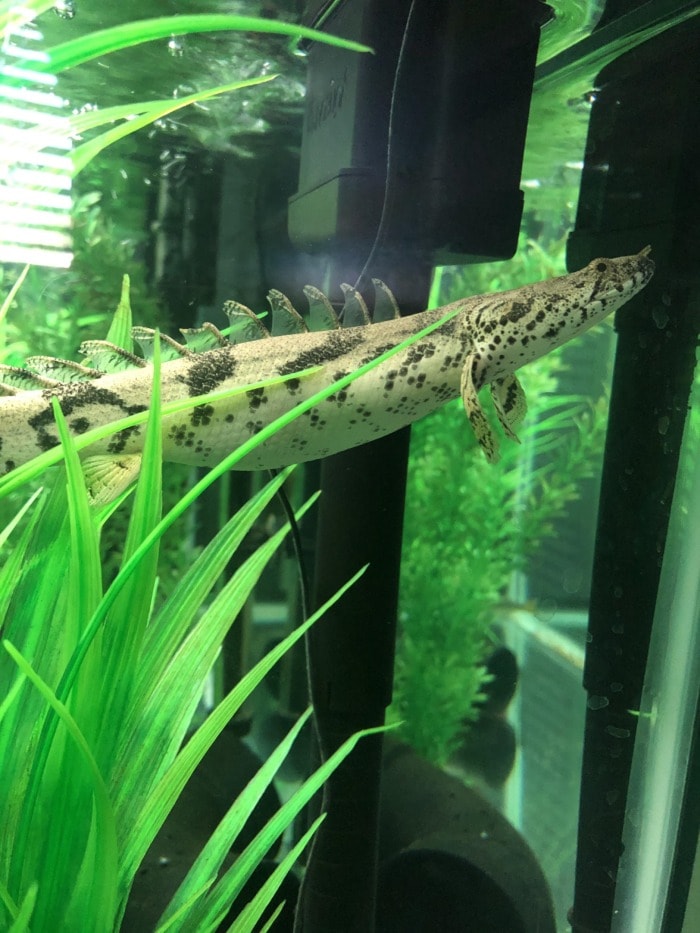
| Water temperature: | 72 to 82 °F (22.2 to 27.7 °C) |
| pH: | 6.0 to 8.0 depending on the species |
| Water Hardness: | 5 to 25 dH |
| Recommended tank size: | 90-gallons for a single one |
| Grows up to: | The more popular species reach between 11 and 23 inches of body length (28 to 58.4 cm) |
If you’re into elongated aquatic dinosaurs then the bichir fish may be your best bet.
Members of the Polypterus genus, the Bichirs are one of the coolest eel-like fish you could ever keep, and it’s not only because of their prehistoric looks.
Typically, Bichir fish are quite peaceful and an ideal tank mate for a large community tank with “monster fish”.

Before I get you excited, I must point out that bichirs grow exceptionally large and need a decently sized tank to thrive.
You’ll need to have at least some experience in fish keeping to get a bichir.
You’ll also need a tank that holds no less than 90 US gallons.
Bichirs inhabit the bottom of the tank so the larger the tank’s footprint – the better.
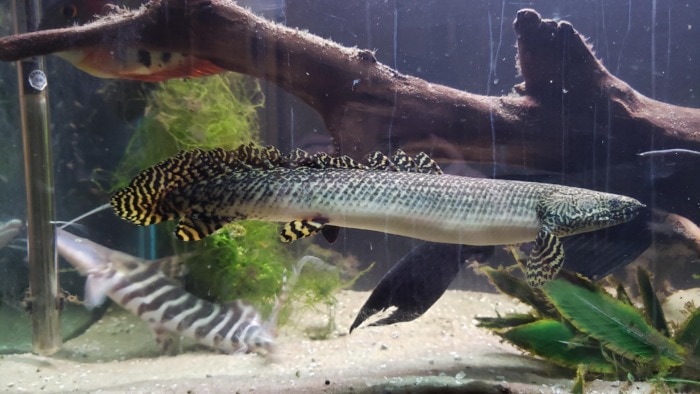
Anyway, bichirs are nocturnal predators and though peaceful they will take a bite out of smaller fish.
That’s because of their predatory nature and not because they’re ill-behaved.
Their tank mates should not be small enough to fit in the Bichir’s mouth and should also be as docile in temperament.
6. Peacock Eel (Macrognathus siamensis)
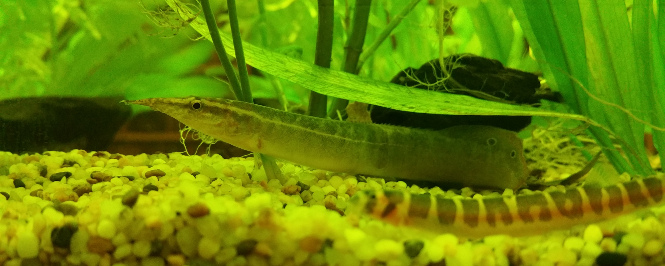
| Water temperature: | 73 to 80 °F (~23 to ~26.6 °C) |
| pH: | 6.5 to 7.5 |
| Water Hardness: | 5 to 15 dH |
| Recommended tank size: | 35 gallons for juveniles and a 55+ for adults. |
| Grows up to: | 12″ (30 cm) |
The Peacock Eel is among the species of the Macrognathus genus of eel-like fish.
If you haven’t kept a spiny eel before this is the species for you.
In the store, they may also be labeled as Striped Peacock eel, Siamese Spiny eel, or Spot-finned Spiny Eel.
This eel-like fish reaches a maximum size of around 12″ (30 cm), unlike the previously listed giants.
This makes them one of the smallest freshwater eels that can be kept in an aquarium.
Therefore the Peacock Eel needs to inhabit a tank with a size between 35 and 55 gallons.
Peacock eels are shy and it may take a while before they feel comfortable enough in your aquarium.
They will hide in the substrate for most of the time, at first.
A fine, non-abrasive gravel layer of 2 inches will do.
This eel has a rather peaceful temperament, making it perfect for community tanks.
Similar-sized, non-aggressive fish are best as tank companions.
The Peacock eel may try to eat small tank mates (think Neon tetras) as these freshwater eels have a predatory nature.
Keep them in communities of ottos, swordtails, guppies, rainbowfish, and the less aggressive cichlids.
Unlike other spiny fish, M. siamensis feels comfortable with others of its kind and won’t get territorial.
If you plan on keeping more than one, make sure they are of similar age, as tolerance comes with size equality.
The tank setup should consist of lots of plants, as these creatures like to hide among vegetation.
Generally, they prefer slow-moving water, as it resembles their natural habitat.
Pristine water is a must with Peacock eels.
Weekly water changes of 20% to 30% are necessary, as well as constant water oxygenation.
As with other spiny eel fish, the peacock one has a lifespan of 8 to 20 years.
Though tropical, the water temperature should not exceed 80 °F (26.6 °C).
Feeding a peacock eel with live food is necessary as these eels are strictly carnivores.
Feed it bloodworm, earthworm, black worm, tubifex, and even white Detritus worms. An eating schedule should consist of 3 or 4 offerings per week.
7. Half-banded spiny eel (Macrognathus circumcinctus)
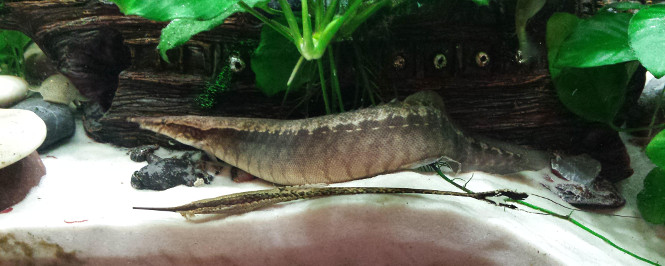
| Water temperature: | 73 to 82 °F (~23 to ~28 °C) |
| pH: | 6.8 to 7.5 |
| Water Hardness: | 5 to 15 dH |
| Recommended tank size: | 10 gallons for juveniles and a 35 to 55 gallons tank for adults. |
| Grows up to: | 8″ (20 cm) |
The Half-banded spiny eel from the Macrognathus genus is among the smallest species in the family Mastacembelidae.
It will rarely surpass a length of 8 inches (20 cm).
Such maximum size allows aquarists to keep this eel in smaller tanks.
Any aquarium setup of 35 to 55 gallons is more than enough.
If you have an aquarium of this size and don’t plan on upgrading to a bigger one any time soon, I highly recommend choosing this spiny eel.
Another thing these guys stand out with is their temperament.
They are quite friendly and outgoing.
Strangers to scandal, the half-banded spiny eels will roam your aquarium, hanging out with other tank mates.
They will occasionally burrow themselves in your substrate though.
Fine sand would be the best choice here.
Floating plants are your best option, but a deeply rooted big plant is not out of the question.
Though they will be active during daylight, you’d still need to provide them with hiding areas.
Bogwood, rocks, and shady places have to be abundant.
All fish that are not considered food will be promptly ignored by M. corcumcinctus.
This includes most any none to semi-aggressive tank mates that are not small enough for the eel’s tiny mouth.
Choose fish that are longer than 2 inches (5 cm) for companions.
Speaking of eating – any live prey will be ideal for the half-banded spiny eel.
Feed it live bloodworm and small crustaceans such as brine or ghost shrimp.
The lifespan of the half-banded spiny eel is significantly shorter than that of its larger cousins.
It will live between 5 and 10 years. In a larger, stress-free tank it can survive for even more than that.
8. Asian Swamp Eel (Monopterus albus)
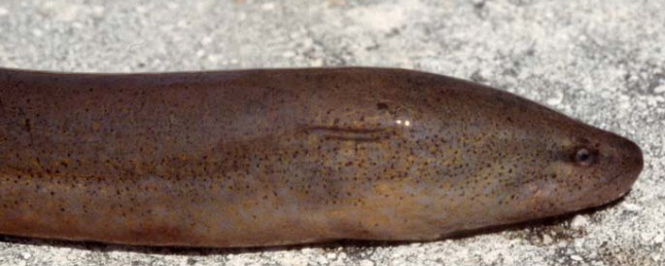
| Water temperature: | 78 to 82 °F (~26 to ~28 °C) |
| pH: | 6.2 to 8 |
| Water Hardness: | 5 to 25 dH |
| Recommended tank size: | 75 gallons for juveniles and a 150 (but preferably 180) gallons for adults. |
| Grows up to: | 45″ (115 cm) |
Only for expert-level fishkeepers.
The Asian swamp eel (or Rice eel) is assigned to the Monopterus genus, and can become a true monstrosity in size.
Occasionally it will grow even larger.
This eel-like fish needs to stretch out fully in its tank.
Aquariums with horizontal dimensions of at least 6 feet are recommended as the bare minimum for adult specimens. Click here to check out aquariums with such dimensions.
The water quality should be kept in check as swamp eels are prone to fungal infections.
The swamp eel is notorious for its aggressive temperament.
As juveniles, their aggression towards other tank mates can get out of control easily.
They will bite, attack, or straight up kill even the larger fish.
This eel-like fish has obnoxiously strong jaws.
When older, it will become more lethargic and it may not show interest in performing genocides anymore.
As an adult, it will prefer to keep its nose close to the water surface.
This fish breathes air so that’s normal behavior for larger, more lethargic specimens.
On this note, it is really best to keep them alone or with others of their kind.
Some fishkeepers do keep them along with other large fish that fall in the 8-10 inch (20-25 cm) range.
As all fish that look like eels, this one needs its hiding areas too, though they are not shy.
Its diet leans towards the piscivorous side.
Your Asian swamp eel pet can be fed feeder fish, small crustaceans, feeder frogs, and invertebrates.
It will not refuse to eat earthworms, bloodworms, shrimp, and even white fish.
The lifespan of the swamp eel is estimated at 8 to 12 years.
9. Rubber Eel (Typhlonectes natans)
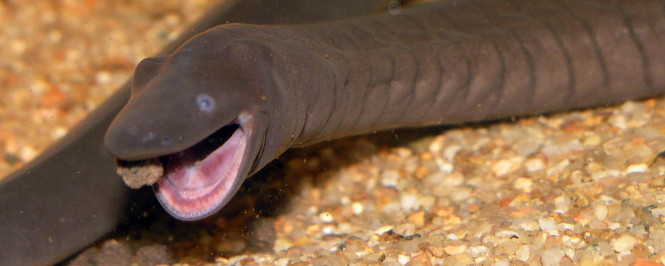
| Water temperature: | 78 to 82 °F (~26 to ~28 °C) |
| pH: | 6.5 to 7.2 for juveniles, adults can tolerate a more alkaline water of up to 8 |
| Water Hardness: | 5 to 15 dH |
| Recommended tank size: | 10 gallons for juveniles and 35 to 55 gallons for adults. |
| Grows up to: | 22″ (55 cm) |
The rubber eel, also famous as a Caecilian worm is actually an air-breathing, legless amphibian within the Typhlonectes genus.
It will swim to the surface to breathe oxygen.
These guys have gone through some weird evolution.
Rubber eels are almost completely blind.
For this reason, they have a rather scavenging habit of feeding and won’t really bother other fish.
Feed them with bloodworms or earthworms and they will be happy.
A caecilian can be kept with small fish, as long as they are active, fast swimmers.
Avoid keeping it with fish that are known to eat slime coats, as rubber eels are very sensitive to the subject.
They like to bury themselves in the substrate so opt for fine sand or gravel to prevent injury.
Provide them with lots of hiding places across the tank.
Even a PVC tube would suffice, but driftwood is encouraged.
Rubber eels can grow up to 22 inches (a little over 55 centimeters) with good care.
By “good” I mean pretty much any level of care, as these guys are mind-blowingly hardy.
The only requirement is that your water is warm and aerated.
These creatures breathe through their skin, but will occasionally find their way to the water’s surface.
Caecilians shed their skin, so don’t freak out when it happens.
Remove the old skin with a net, to avoid spoiling the aquarium water.
These prehistoric creatures are rare in local fish stores.
There are some legal issues around their import and export.
You may have a hard time finding one for sale.
Anyway, despite their size, Rubber Eels don’t require a large tank.
The estimated lifespan is around 5 years.
10. Kuhli / Coolie loach (Pangio kuhlii)
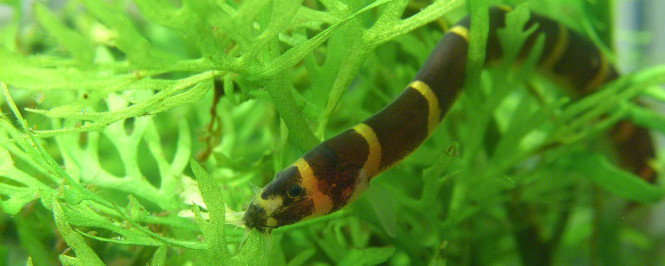
| Water temperature: | 76 to 86 °F (24.5 to 30 °C) |
| pH: | 5.5 to 6.5 |
| Water Hardness: | 5 to 10 dH |
| Recommended tank size: | 20 gallons for a school of juveniles and 125 gallons for adults. |
| Grows up to: | 4″ (10.1 cm) |
The Kuhli loach from the Pangio genus is a long fish that looks like an eel.
It’s relatively small in size which makes it a great addition for medium sized community tanks.
Because of their unique appearance and coloration, I actually placed them on my list of the coolest and most colorful freshwater fish. They don’t grow much, have curious personalities, and enjoy the company of others.
The Kuhli loaches grow to a maximum size of 4 inches or about 10 cm.
Such a tiny size effectively makes them the smallest fish that looks similar to an eel.
Though a 10-gallon tank seems appropriate this is not the case here. That’s because Kuhli loaches are schooling fish, which means they need to be kept in groups.
Kept alone they will spend their time hiding as they don’t like socializing with other fish.
However, when in a school with more of their kind, they will feel confident enough to roam your tank more often.
This implies that for juveniles a 20-gallon tank will be the bare minimum if you want them to be happy. For a school of 5 to 6 adult coolies, it’s recommended to provide a 55-gallon, long tank or something with a similar horizontal length.
Other than that they strongly resemble eels in behavior.
These creatures are mostly nocturnal and will scavenge for food after sunset.
Burrowing in the sand is among their favorite activities.
Avoiding sharp aquascape and gravel comes without saying.
Fine sand is the best substrate option for the Kuhli loach.
Larger gravel may promote injury.
Another eel-like trait of theirs is the tendency to squeeze through the tiniest hole.
These guys are super curious and will find their way through almost any slit.
Securing your filter’s outlet is a recommended safety measure.
Suitable tankmates for a Kuhli loach are any fish that are peaceful in nature.
As opposed to other larger eels, in this case, the danger comes from tank mates eating your eel-like pet and not the other way around. A rule of thumb is that any well-mannered community fish will do here.
A Kuhli loach will mainly hang out at the bottom of the tank.
Bottom-dwellers are not an issue as Kuhlis tend to get along with them.
In terms of feeding these eel-like fish prefer to scavenge for their food.
They will eat live and frozen foods, along with pellets straight from the bottom.
As a source of live food, you can feed them bloodworm and tubifex or brine shrimp.
When feeding with pellets choose the sinking ones.
Flakes meals should come from a quality brand.
Occasionally offer a herbivore pellet.
There’s a myth circulating the Internet that the pangio kuhlii will eat snails. Unfortunately, this is not exactly true but there are enough other fish that do in fact eat aquarium snails.
With the Kuhli’s rather impressive lifespan of 10 years, you may have enough time to find out the truth for yourself.
11. Reedfish (Erpetoichthys calabaricus)
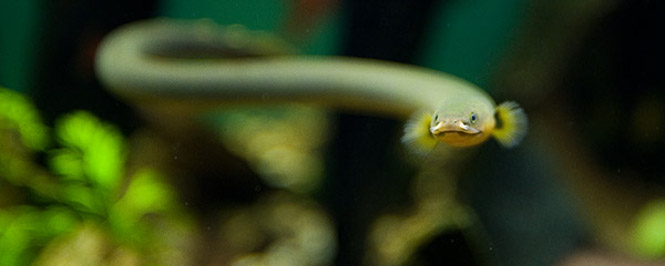
| Water temperature: | 73 to 82 °F (~23 to ~28 °C) |
| pH: | 6 to 7.5 |
| Water Hardness: | 2 to 15 dH |
| Recommended tank size: | 30 gallons for a single juvenile and 55 gallons for an adult. |
| Grows up to: | 18″ (45 cm) |
The reedfish, also known as ropefish, is a large, yet docile eel-like fish species.
They are friendly and curious, but will not bother your other fish.
The Reedfish, the only member of the Erpetoichthys genus, can actually live in both freshwater and brackish aquariums without any issues. For this reason, I’ve also listed them as one of the best and most interesting brackish water fish that you could keep at home.
Anyway, though in the wild they will reach a mature size of up to 3 feet (90 cm), in captivity Reedfish maximize their growth at no more than a foot and a half (45 cm).
This makes a 55-gallon tank suitable for a solo ropefish adult.
Nonetheless, these eel-like fish are very social and enjoy the company of one another.
To stimulate their activity in the tank you should keep 2 to 3 at a time.
This way they become way less boring and will browse the bottom more.
In such a scenario, 75 to 125 gallons would be an appropriate-sized tank.
They are quite flexible and do not really need to stretch out fully inside the aquarium.
However, when in a group they are fairly active and need their swimming space.
Still, the occasional hiding place should be provided as they are, after all, eel-mannered.
Speaking of which, they do go on a hunt for prey at night.
The tankmates for your reedfish should not fit in its mouth by any means.
Another thing to consider about companions is that they should not be aggressive either.
A reedfish is pretty calm in its nature and may get bullied by more aggressive fishes.
Avoid keeping it with plecos, as they will disturb its slime coat, which can turn out lethal.
Feed your ropefish live food such as small feeder fish, earthworm, bloodworm, and insect larvae.
This “eel” breathes atmospheric air, despite having gills.
In the wild, they inhabit swamp-like stagnant or slow-moving water.
This resulted in them evolving lung-like organs.
It is not uncommon for them to swim to the surface to have a gulp of oxygen.
12. Electric Eel (Electrophorus electricus)
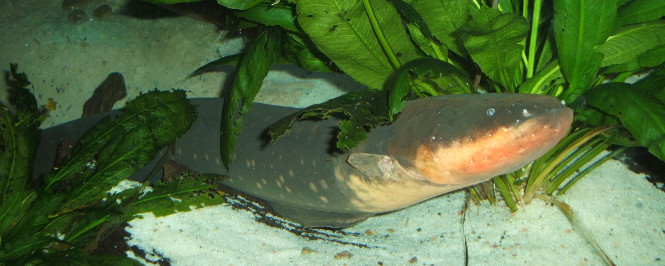
| Water temperature: | 73 to 82 °F (~23 to ~28 °C) |
| pH: | 5.5 to 6.5 |
| Water Hardness: | 1 to 12 dH |
| Recommended tank size: | A tank the size of Mount Olympus (100+ gallons for juveniles and 540 gallons for adults). |
| Grows up to: | 95″+ (240+ cm) |
Even though you can have an electric eel as a pet, I wouldn’t recommend getting one unless you’re a top level specialist.
These fish are worldwide famous for a reason.
The electricity they produce can reach up to 600 volts and 1 ampere.
A repetitive electrical shock of this proportion can stop the human heart, resulting in death for the unlucky owner.
It grows up to 8 feet (240 cm), but larger species have been recorded.
You’d need a huge 540-gallon fish tank to house a single adult.
Not to mention a solid filtration system as these fish can really make a mess.
Obviously, this is not the scary part.
Needless to say, you can’t keep an electric eel with other tank mates, unless they are of their own kind.
On top of that, these guys are plain ugly and have a really boring personality.
Whenever they grow larger all they will do is hang out on the bottom, motionless.
In the wild they will spend days like this, waiting for prey.
In nature, electric eels are found in stagnant swamp waters where the oxygen is really low.
Because of this, they would have to swim to the surface to breathe atmospheric air.
In a fish tank, this would be the only exciting movement you’ll see from it.
They are so boring, in fact, that some fishkeepers install speakers that monitor the electrical charge in the water.
Upon feeding, the eel produces massive charges and the speaker transmits them as sound.
The sound very much resembles a Geiger-Muller counter near a nuclear reactor.
Here’s a video example:
To make matters worse, these eels require a tremendous amount of space.
If you’re going to keep them as pets, you’ll need a tank with a size of 540 gallons.
When it comes to feeding you can offer this eel pretty much anything that will fit its mouth.
As a carnivorous predator, it will eat whitefish, trout, invertebrates, amphibians, and even small mammals.
Really, an animal for extreme fishkeepers.
It also has a lifespan of over 15 years.
13. African lungfish (Protopterus annectens)
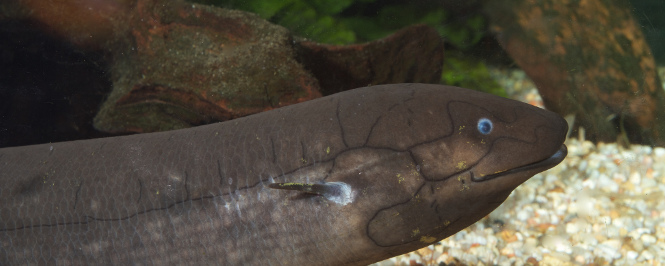
| Water temperature: | 75 to 86 °F (~24 to ~30 °C) |
| pH: | 6 to 8.5 |
| Water Hardness: | 1 to 10 dH |
| Recommended tank size: | 55 gallons for juveniles and anything above 75 gallons for adults. |
| Grows up to: | 32″+ (81 cm) |
The African lungfish is a member of the small Protopterus genus, which includes just four species.
This eel-like creature is ancient.
Research claims that It has stayed physically the same for millions of years.
Perhaps, that’s because it has evolved a ton of survival mechanisms, so no more evolution was needed.
But enough speculations.
They have a really strong jaw and can bite off parts of their tank mates at will.
Yet, they are mostly calm and don’t move around as much.
The P. annectens will grow up to a size of 40 inches in the wild (1 meter).
In captivity, however, they will rarely reach more than 30″ (or 75+ cm).
Following these facts, there are two conclusions to be made.
This fish is better off alone in a tank.
They won’t tolerate their kind and may snap on other fish.
The tank they should be kept in should allow them to fully stretch and turn around but that’s about it.
They are not active swimmers so a 36″ long tank would do.
Any tank of 65 gallons or above will do for an adult lungfish.
They are classified as omnivores, but their diet can be 100% meat.
An African lungfish will eat just about anything – white lancefish, prawns, mussels, worms, crustaceans, shrimp, frogs…
They will eat pellets as well, occasionally algae wafers can be offered too.
Mature specimens can be fed whole live fish.
As a carnivore, the lungfish will produce copious amounts of waste.
Your filter should be top of the notch to keep the water at a healthy level.
The water movement should be kept down to a minimum.
These fish like dim lighting, and don’t really bother with the decor.
They do enjoy a sandy (or better yet – muddy) substrate so make sure it has at least 3 inches of that.
The lungfish needs to be able to reach the water surface, as well.
They breathe mostly atmospheric air, as they have a rather sophisticated lung-like organ.
You can own this boring eel as your pet for about 18 years with proper care.
Freshwater eels care tips and peculiarities
Keeping a freshwater pet eel certainly sounds like a great idea on paper.
They have an exotic appearance, charming personalities and can even be fun at times.
However, their size and dietary requirements can make them difficult to care for.
There are general similarities between all the eel fish, that need to be taken into consideration by any future eel owner.
Here’s what to be wary of when caring for your freshwater eels:
- steady lids/hoods – all of the aforementioned species are escape artists.
They will escape if your lid is not securely positioned.
They are all surprisingly intelligent and unimaginably curious.
All of them without exception have the physical ability to squeeze even through the tiniest opening.
Secure all possible openings, be it with a plastic bag or some other barrier.
There are just too many records where an eel escapes the aquarium of a clumsy fishkeeper.
Some of them can survive a fair amount of time on land and will make the trip to freedom.
Others will get injured from the drop and possibly die without water.
In either case, you don’t want them outside of your aquarium.
- water conditions – these eels are rather hardy, but do not forget they are tropical in their nature.
Some will be more temperature-sensitive than others, but overall try to stick to the recommended values.
Most of them will require pristine water.
The lack of scales leaves them prone to parasites and illnesses.
Keep your water condition in check and perform the needed water changes.
Do not use medication that includes copper in an eel aquarium.
- dimmed lighting – all fish that look like eels would require a dim light (except, perhaps, the Kuhli loaches).
They are all shy in their nature and are mostly nocturnal.
A dimmed light simulates their natural habitat.
This encourages the eels to be more active in the aquarium.
You can achieve that effect by having lots of floating plants, for example. I know that choosing the right lighting for a large aquarium can be difficult, so click the link for a guide I wrote to help with that.
- soft, fine substrate – every self-respecting eel will occasionally burrow itself in your substrate.
This imposes the use of a fine, non-abrasive substrate.
Fine grade sand is a universally accepted solution for eelkeepers.
- strong filter – as carnivores, these fish will produce a massive waste load.
A weak or low-quality filtration system is not an option here.
The water will get contaminated fast.
As most of the eel fishes grow large, the aquariums they require will also be large.
Do not compromise with the filtration system. Buy a high-end filter that will be able to handle all the waste. Visit the link to an overview of some of the stronger canister filters on the market.
Don’t know what a canister filter is? Click here to find out.
- deep-rooted or floating plants – as the eel-like behavior implies, your plants may get uprooted.
Thick and well-planted plants will likely survive.
The better option here is to switch to floating live ones. This way they will sufficiently subdue the lighting while saving you worries.
- hiding places – all aforementioned species like to hide, except the really huge ones.
Provide them with long, narrow spaces.
If you don’t think it looks too ugly, a PVC pipe is a really good choice.
Artificial caves and carefully executed rock work will do.
Avoid having too many sharp objects, though.
These fish are bottom-dwellers and upon hiding they may harm themselves on the sharper edges.
- aggression and compatibility – most of the species listed above are either semi-aggressive or full-blown psychopaths.
To avoid conflict, keep them with larger fish of the same temperament.
Usually, the small ones such as the Kuhli loach or the half-banded spiny eel will not be as problematic.
- diet – if you’re about to tame a freshwater eel you’d need a good amount of bloodworm supplies.
In general, the eels will eat all kinds of worms, ghost shrimp, and krill.
Accepting pellets is a rarity.
Finally, one good online store where you can actually buy a freshwater eel fish is Blue Grass Aquatics. I’m not affiliated with them, it’s just one of the few stores I know that can handle such a specific fish. Another great choice for a fish store for that kind of animal would be The Wet Spot Tropical Fish which I’m also not affiliated with and just like.
My Final Thoughts
Though I wouldn’t recommend to anyone to rush and get an eel for their home fish tank, it’s still possible with the right approach.
Eels-mannered fish can be a cool addition to any freshwater aquarium or even its centerpiece attraction.
Having the knowledge from this guide, are you prepared to start an eel tank of your own?
Tell me about it in the comments or ask me a question.


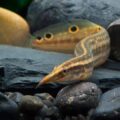



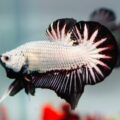


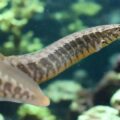
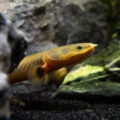

Has anyone had experience with Asian Swamp eels?
I rescued one from a Chinese market….had a good size tank….all the accessories.
He died within 4 days!
What is the best fungicide to use?
I had a rubber eel in college. It was my FAVORITE fish ever. I didn’t know the life span was only 5 years, so I feel better about it dying. (It died a little before 5 years. I spent years wondering what did I do wrong. I remember I almost killed it when it escaped. I thought it was a snake b4 last minute looking at my fish tank. lol I told myself that I will not get another aquarium until I have a house b/c I want a 100-gallon tank. 2 rubber eels shall be the first to go in my tank. Good read.
Hi,
It sounds like you were a good eel parent and squeezed the most of it, actually. So I’d say a good job to you!
Also, many thanks for sharing your story. Appreciated!
Momchil
Great, informative article. Thank you! I had an eel years ago in a 29gal. I had gotten it from a local amazing aquarium shop. They had ONLY fish/aquariums and were very knowledgeable. They actually taught me how to care for fish and keep a tank thriving, a point to which I had been unsuccessful too many times to count prior. Anyway, back to the eel. It was THE BEST!!! I absolutely loved it. It was buried in the substrate around 90% of the time. I saw it only occasionally, but it truly made my day when I did see it. When I woke to see it first thing, it always meant it would be a good day. I stumbled on this article when trying to research for a new tank I’m setting up now.
Hi Jen,
Thanks for sharing your experience with me. Freshwater eels can be a massively cool pet, I agree.
What type of eel do you keep?
Best,
Momchil
I have absolutely no idea what kind it was. I was searching to try to figure that out. Based on the research I’m finding, I am guessing it was a half banded spiny eel. I have had loaches since with the hopes of recreating the “feel” of having an eel I the tank, but they just weren’t ever the same. I desperately want to find another for the new tank I’m starting up.
It also lived very peacefully in the tank with small schooling fish (schools of a handful of different tetras) and a dwarf gourami (another of my all-time favorites).
Sounds like a very fun community tank to me!
Good luck on your search for your new pet eel 🙂
Best,
Momchil
Are kuhli messy eaters? Because I don’t want my fish to get sick. Also, would they be fine if I got two of them
Hi Nathan,
Kuhli loaches do not create a mess in the aquarium in my experience. They scavenge the bottom for leftover foods.
You could keep 2, but with Kuhli loaches you’d want to have more. When in groups of 6 or more they feel very confident and stay in the open more. If you only keep two, they will likely remain in their hideouts and show that much.
With that being said, it’s very rewarding to have a large group of these fish, as they have such cool personalities!
Great information, thanks for sharing! I’ve been considering getting a M. circumcinctus for a while now, have a nice little 10g, heavily planted and decorated, dimly lit aquarium with a sand substrate. He will be the only animal in the tank besides a couple snails. I’m torn between a spiny eel and a pea puffer now because I’m afraid I might never see the eel if it’s always hiding. What are your thoughts? Thanks!
Hi,
The half-banded spiny eel is very active and a curious explorer compared to most other freshwater eels. If you’re going with that particular species, then you should not be worried about not seeing it, IMO.
That being said, some spiny eels will be more outgoing than others, so keep in mind that the animal’s individual character plays a role too.
Pea puffers have a ton of personality but can be more challenging to keep because they require pristine water quality, yet make a mess every time they feed.
So, if I were you I’d probably go with the eel as it’s still a really cool aquarium oddball. 🙂
Khuli loaches, reed fish, and lung fish are not eels. Also wikipedia wants their images back.
Hi,
Well, evidently, they are not. All of these are not true eels – it says it in BOLD at the BEGINNING of the article.
Wikipedia images are free to use, as long as you give appropriate credit. That’s the whole point.
All due respect, but it seems to me you’re trying to be edgy without having read the article…
I’ll leave your comment anyway so that other people can see what kind of person you are.
Have a great day.
Grow up, Steve.
Or put a big male dwarf sized eel with a pair of breeding bowfin fish
Hi,
Sure, both should be able to be fend for themselves.
Keep me updated.
I thought about putting a eel that only gets a big 9″ and aggressive with a pair of 11inch pike cichlids.
We found a ~2″ long american eel on Cape Cod seashore – it was trying to a get into a small stream of brakish water. We brought it home and put it
into our freshwater fishtank. This was ~12 years ago. It is still alive, about 12″ long now but mostly stopped growing long time ago. We change water in the fishtank every 2-3 years.The tank is unheated. Sometimes we do not feed the eel for weeks. Most of the time I just feed it some human food (ham or bologna) but also try to give it some frozen worms. This is the most resilient fish we ever had – most other die off after ~2-3 years max in our tank.So I am quite surprised about your comments above about american eels not suitable for freashwater tanks.
Hi and thank you for input,
Nothing to be surprised about that comment, you likely prevented it from trying to breed. Being resilient does not necessarily mean you should live an unfulfilling life. The eels do spend a portion of their life in freshwater (as noted in the article) and they could probably survive that, but that was not the point of that article. Freshwater eels are, as stated, eel-like fish and not a true eel. True eels have a natural tendency to migrate to saltwater to breed. You say you don’t feed it for sometimes weeks and that the tank is unheated. This may be the case in nature as well, but in nature, the eel has the liberty of swimming freely and deciding where to spend its time. If you keep something in your aquarium at home, my understanding is that you should try to provide the very best conditions for the animal at the cost of its freedom. From your comment, I understand that you provide your eel with the rough conditions of living in the wild, but also limiting its freedom. I don’t get that.
I’m sure that a lot of people have mistreated their pets due to a lack of information and proper research (myself included when I was in the beginning). However, the point of having a pet is not for it to survive, but to actually enjoy its life.
Best of luck
Stupid cow, why write about mistreating an animal fOr years as it a successful story. EVIL.
Rude and mannerless much, K?
Great info. I had a Rubber eel some years ago, forgot it was in tank due to it burying itself all the time. I fed her earth worms from my backyard she loved them, green slime came out of her mouth prior to eating. She grabbed my pinky to the first knuckle one time. We Found her outside the tank on the floor she also had three babies we clean them off put them back in the tank and sold them all about
2 and 1/2 years later.
Hi Jim,
Thanks for sharing your experience with me. Interesting story
Cheers